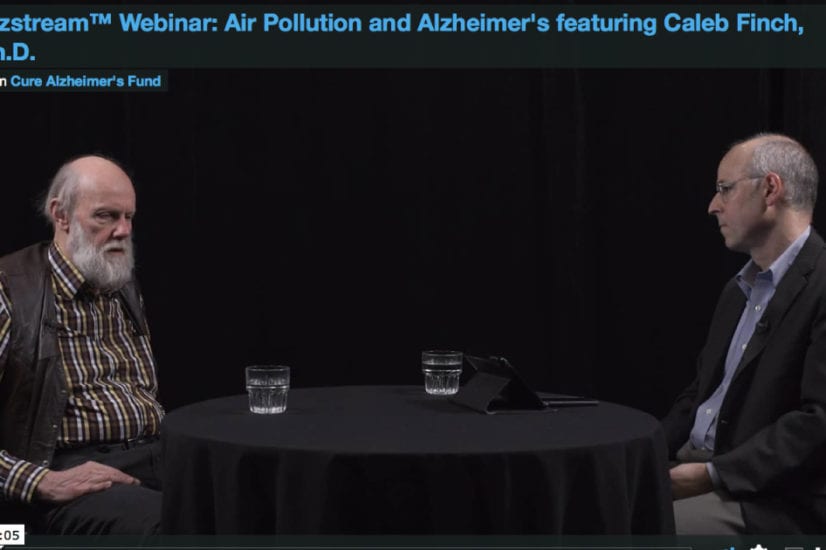
Posted November 12, 2012
Consensus among Alzheimer’s researchers about the origins of the disease is growing. Most, including members of Cure Alzheimer’s Fund Research Consortium, agree that a combination of factors, beginning with the excessive build-up of the peptide Abeta42 triggering the development of tau tangles, nerve cell death, and inflammation are all required for Alzheimer’s pathology.
The Wall Street Journal and other publications recently highlighted efforts to interrupt the formation of tau tangles. Rudy Tanzi, Chair of the Cure Alzheimer’s Fund Research Consortium, Professor of Neurology at Harvard Medical School, and Director of the Genetics and Aging Unit at Massachusetts General Hospital offers the following commentary on this recently announced work:
Over the past two decades, we have learned from genetic, biochemical, and neuropathological studies that the neurodegenerative process in Alzheimer’s disease begins with the excessive accumulation of beta-amyloid in the brain. Virtually every confirmed Alzheimer’s gene leads to the same outcome: abundant beta-amyloid deposition in the brain, albeit via different mechanisms stemming from amyloid beta deposition and clearance in the brain.
We also know that while beta-amyloid is necessary to start off the neurodegenerative cascade of Alzheimer’s, it is insufficient on its own to cause the disease. Beta-amyloid triggers the production of tangles in nerve cells. As tangles accumulate in nerve cells, the cells become dysfunctional and die. As nerve cells die, the brain undergoes an inflammatory reaction that kills yet more nerve cells. So, our current understanding of Alzheimer’s includes a pathway in which excessive accumulation of beta-amyloid acts as the triggering event (as confirmed by genetic findings), followed by tangle formation (induced by beta-amyloid), nerve cell death, and finally inflammation. As nerve cells and their connections (synapses) are increasingly lost, dementia ensues.
Most Alzheimer’s therapies currently in development are aimed at curbing the beta-amyloid deposition in the brain. This approach is logical as it allows Alzheimer’s to be nipped in the bud stage given that beta-amyloid deposition starts off the disease process. An alternative strategy is to allow the beta-amyloid to accumulate but try to stop the tangles from forming in response to the excess amyloid. In fact, many believe that we will ultimately treat Alzheimer’s with a drug cocktail that hits both amyloid and tangles.
One therapeutic strategy for stopping tangle formation is being developed by the company TauRx. Tangles are made up of the protein called tau. Tau abnormally aggregates in the twisted filaments that make up tangles. In an attempt to stop this process, TauRx is using a chemical dye that is over 120 years old, and was actually used in 1891 in an attempt to treat malaria. The chemical is called methylene blue and was originally used as an early dye to stain cells for visualization under a microscope. TauRx renamed this classical dye, “Rember”, and claims that it blocks tau aggregation and tangle formation.
The original clinical trial data for this drug in Alzheimer’s reportedly led to some cognitive improvement but the results were not particularly compelling and viewed by most as equivocal. The study showed that Alzheimer’s patients taking 60 mg of Rember suffered less cognitive decline than those on placebo after 50 weeks of treatment. However, the higher dose of Rember, 100 mg, led to no improvement, casting doubt on the clinical results. Further clinical trials on Rember are currently underway, and we await the phase 3 trial results.
While the Wall Street Journal article pits beta amyloid-based therapies against tau tangle-based therapies, it must be emphasized that the successful treatment of Alzheimer’s disease does not involve a competition between drugs aimed at either beta-amyloid deposition or tangle formation. Many believe that successful treatments could consist of drug cocktails that achieve both. Gene defects that cause Alzheimer’s clearly show that beta-amyloid is sufficient to initiate Alzheimer’s. Other studies have shown that beta-amyloid triggers tangles in nerve cells. Thus it is reasonable to develop therapies aimed at stopping both amyloid and tangle formation. With that said, whether a 120 year old cell-staining dye called methylene blue now reinvented as the drug “Rember”, will clinically stop tangle formation and improve cognition in Alzheimer’s patients remains to be seen. In any event, tangles are as viable a drug target in Alzheimer’s as beta-amyloid and most would agree that a drug cocktail hitting both would be optimal for slowing, stopping, or reversing this dreadful disease.
Cure Alzheimer’s Fund supports Abeta and Tau research, believing it’s important to understand all mechanisms of action which contribute to Alzheimer’sdisease. Additionally, investigators researching both areas are represented on our Research Consortium.





